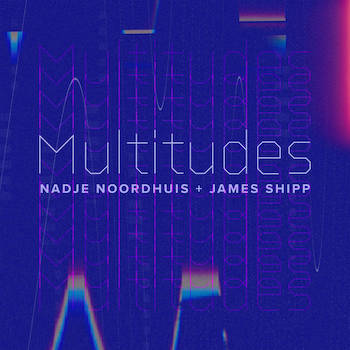Jazz Album Review: “Multitudes” — A Plethora of Pleasant Acoustic and Electronic Sounds
By Michael Ulllman
These pieces integrate the various, varied sounds James Shipp and Nadje Noordhuis produce into something rhythmically as well as melodically exciting and coherent.
Nadje Noordhuis and James Shipp, Multitudes (Little Mystery Records)
The amusing title of this new session by trumpeter Nadje Noordhuis and James Shipp, who is described as a vibraphonist/percussionist/synthesist, comes from the most famous passage in Walt Whitman’s Song of Myself:
Do I contradict myself?
Very well then I contradict myself,
(I am large, I contain multitudes.)
The duo previously made a mostly acoustic album, Indigo, which Shipp describes as a “pure duo,” with a sprinkling of synthesized sounds “here and there.” It was that almost live album that gave them the idea for Multitudes, with its plethora of acoustic and electronic sounds. Shipp explains: “The decade I’ve been playing with Nadje has been the decade of my getting into analog synthesizers and electronic instruments and effects.” To create some pieces, the duo pre-recorded a background and then played over it. Shipp would take what they had produced and edit or rework the background. “It was like we were sending a letter back and forth to ourselves through time.” They would record, at home, meet at the studio, and change things up: “It was many layers of us, and us revising the way we were accompanying ourselves.” They were the multitudes.
 They make it sound fun. “Candlestick Carol’ begins with Shipp playing a melody on what sound like high-pitched bells: Noordhuis enters with her luxurious tone slightly muffled. Soon she is playing a slow, rich melody before both she and the now complicated accompaniment, which include those bells, a bass line and held bass notes and percussive sounds (rattling sticks included) become energized. (It must have been time to open the Christmas presents.) On this track the sounds include “a surprising collection of brass candlesticks tied together on a string.” It’s technically adept music with plenty of heart: the piece commemorates the first Christmas Shipp spent without his family. “Encantamento “was produced differently. Noordhuis played a solo piece, which Shipp took home with him and then added the sounds we hear: the echo effects applied to the trumpet, the pattering of what sounds like (but isn’t) bongos, and other percussive effects, including single staccato notes in the bass. These move from side to side in a kind of dance. “Run Together” finds Noordhuis playing gorgeous long tones over high pitched, anxious-sounding figures on the synthesizer. Suddenly, everything becomes grand. There’s a swell in volume and Shipp seems to be bringing in an orchestra. The title cut, “Multitudes,” begins with another fast-moving rhythmic pattern on what sounds like (but probably isn’t) an electric piano. Noordhuis solos over this movement in what sounds like splendid isolation: there’s no interference with her basic tone.
They make it sound fun. “Candlestick Carol’ begins with Shipp playing a melody on what sound like high-pitched bells: Noordhuis enters with her luxurious tone slightly muffled. Soon she is playing a slow, rich melody before both she and the now complicated accompaniment, which include those bells, a bass line and held bass notes and percussive sounds (rattling sticks included) become energized. (It must have been time to open the Christmas presents.) On this track the sounds include “a surprising collection of brass candlesticks tied together on a string.” It’s technically adept music with plenty of heart: the piece commemorates the first Christmas Shipp spent without his family. “Encantamento “was produced differently. Noordhuis played a solo piece, which Shipp took home with him and then added the sounds we hear: the echo effects applied to the trumpet, the pattering of what sounds like (but isn’t) bongos, and other percussive effects, including single staccato notes in the bass. These move from side to side in a kind of dance. “Run Together” finds Noordhuis playing gorgeous long tones over high pitched, anxious-sounding figures on the synthesizer. Suddenly, everything becomes grand. There’s a swell in volume and Shipp seems to be bringing in an orchestra. The title cut, “Multitudes,” begins with another fast-moving rhythmic pattern on what sounds like (but probably isn’t) an electric piano. Noordhuis solos over this movement in what sounds like splendid isolation: there’s no interference with her basic tone.
What is striking to me is how just plain pleasant the synthesized (as well as acoustic) sounds we hear on this collection are. We are light (sound?) years away from the strained synthesized strings of the early years of such recordings. These pieces integrate the various, varied sounds Shipp and Noordhuis produce into something rhythmically as well as melodically exciting and coherent. The ten-number set ends with the particularly beautiful song, “To Say Goodbye,” in which Noordhuis on flugelhorn plays a kind of hymn that is both solemn and ravishingly sensuous. Shipp accompanies with comping chords like a respectful jazz accompanist. Towards the end, Shipp also contrives to introduce bird-like sounds, as if to say that the processes of making this music, complicated to us, were as natural to them as the song of a bird.
Michael Ullman studied classical clarinet and was educated at Harvard, the University of Chicago, and the U. of Michigan, from which he received a PhD in English. The author or co-author of two books on jazz, he has written on jazz and classical music for the Atlantic Monthly, New Republic, High Fidelity, Stereophile, Boston Phoenix, Boston Globe, and other venues. His articles on Dickens, Joyce, Kipling, and others have appeared in academic journals. For over 20 years, he has written a bi-monthly jazz column for Fanfare Magazine, for which he also reviews classical music. At Tufts University, he teaches mostly modernist writers in the English Department and jazz and blues history in the Music Department. He plays piano badly.
